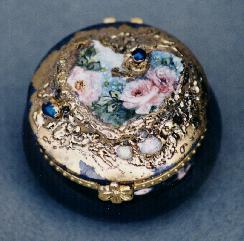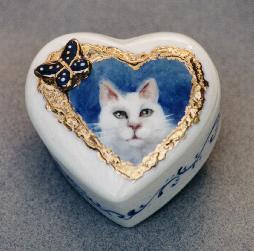The old Regal or Salton heating trays (the kind used to keep food
warm at a buffet) are suggested by Bonnie Crandall as ideal for warming
gold and china for the gold application. A heating pad works equally
well.
To soften Roman gold, first use a few drops of acetone or nitro benzine
solvent, then add just enough thinner to keep the right consistency
of gold. You can use lavender oil as your thinner, but be careful not
to add too much at a time as it will not evaporate as quickly as the
solvent. The lavender oil will keep the gold workable for a longer time.
Regular resist can be used to protect areas when you apply the gold.
Be sure to let the gold dry enough that it will not smear when you remove
the resist.
(added by Marci Blattenberger): Auto body striping tape, which can be
purchased at most auto supply dealers, also makes an excellent mask
for gold. It is stretchy and can be pulled tightly around box and vase
corners.
It is also available in a wide width that is actually multiple strips
with spaces in between covered with a clear strip. After burnishing
the tape to the surface of the china, remove the clear over strip and
you have perfectly spaced strips with open areas in between that make
excellent fine lines....
Be sure to remove the tape carefully before firing
If you don't have a banding wheel to paint even smooth circles, try
contact paper. Use a compass to mark out a circle the size you want,
cut it out and carefully smooth it over the surface of your plate. Place
2 or 3 layers of masking tape over the center and use the compass to
find the exact center of the plate and mark it on the masking tape.
The tape will hold the point of your compass while you cut the contact
paper. First draw the circles with pencil or pen, where you want them.
Place a thin Xacto knife in the compass (you may have to bend open the
part that normally holds the pencil). Secure the Xacto knife with tape
in the compass.
Use a #11 blade and be sure it is at the correct angle for cutting the
circle. Carefully and slowly rotate the compass, cutting through the
contact paper. Gently remove the cut portions of the contact paper where
you want the gold band. Burnish the cut edges with a spoon or other
smooth object to assure a tight adhesion.
Inspect the open area to be sure there is no glue residue and remove
any you find with a cotton swab. Paint the gold.
When the gold is set firm, but not dried hard, carefully peel away the
contact paper mask and you have clean circles of gold.
A banding wheel is much faster and easier.
Keep separate small containers of lavender oil for each type of gold.
Wash the separate brushes in the oil, then in alcohol. When the oil
has become heavy with gold residue, let it set and reclaim the gold
at the bottom for first applications.
The residue from Roman gold can be washed in solvent to remove the
oils. When the gold has settled, pour off the top layer of solvent.
Over time, you will collect enough gold to form a new paste by mixing
it with a few drops of Balsam Copaiba. Use it as unfluxed gold.
If you don't want to wash your gold brushes, store them in a tight
container with a small container or blotter saturated with lavender
oil or Clove Oil. The brushes stay soft.
Gold and lusters can be applied with a small wedge of cosmetic sponge
clipped in an electrical alligator clamp which has a small brush handle
or dowel stuck into its open end. These sponges work nicely for applying
gold to rims of dishes, or can be used to dab the gold or luster onto
a surface.
Ann Cline recommends letting the Roman gold decoration get cool before
burnishing with sand. She says "if you aren't careful you can burnish
the gold right off the piece if it is still warm from the kiln."
A wayward scratch in your burnished gold can sometimes be removed
by rubbing with a silver polishing rag or by polishing with toothpaste.
Those annoying purple smears can often be removed with a gold eraser,
or use the pencil style typewriter eraser. Be cautious not to scrub
so hard you scratch the glaze surface. If the eraser doesn't work, use
a cotton swab moistened with Whink and then wash it throughly.
Lusters can be applied over fired gold to achieve some unusual and
striking effects. For antique gold look, use Roman gold (burnished),
then apply one or two fires of green luster over the gold. Several painters
also recommend putting mother of pearl luster over gold for unusual
effects.
Many of us have discovered that liquid bright gold does not always
fire the same way over some fired china colors. Liquid bright gold over
greens often result in ugly black or brown spots on the fired gold.
To be safe, don't put liquid bright gold over green without testing
it first.
However, Leona Julian reports that liquid bright gold over Coral Brown
(a peach pink from Kay Knapp) produces an antique silver which can be
very attractive. Rule of thumb: Test your colors with gold before using
it on a major piece.
For those wanting a matte gold look, without the cost or trouble
of burnishing, Freddi Kay recommends painting first with yellow brown,
padding it smooth and firing. Then cover with liquid bright gold and
fire again.
Marci Blattenberger has a solution to getting gold on the raised
paste and not on the surrounding china. Use unfluxed gold. It will stick
to the raised paste, because the paste has flux in it, but won't stick
to the clean glazed china. When you burnish the gold, you will rub off
gold on the unfluxed china surface. Be sure there is no paint underneath,
or the gold will stick to the fluxed paint.
Refer to Marci's web site for a discussion on how to use Base for
Gold.
(Note from Marci: The information is curently on Betty Gerstner's original
website):Click
here to go to Marci's pages on textured gold and dichroic glass fusion

Round box with base for gold texture
(LB Gold over)and Dichroic glass
by Marci Blattenberger |

heart box with raised gold texture
by Marci Blattenberger
|
A drop or two of liquid bright gold in a bottle of Mother of Pearl luster
will make it more colorful. However, use caution; too much will make
it a gray color. Ann Cline advises one drop at a time and test fire.
Betty Turner suggests mixing one part liquid burnish gold with one part
liquid bright gold for a richer look.
The following tip is from Frackelton's book, Tried By Fire, published in
1886 and shared by Bonnie Crandall:
"If you want the burnished gold to have a
brilliant shine, mix a little whiting and water into a paste; after you have
gone carefully over the whole surface with your burnisher, put a little of the
whiting with a soft cloth, to remove the grease which arises, in spite of
Fate, on the surface.
This will dry immediately. Wipe it lightly and
carefully away, and then repeat the burnishing, and unless you have made some
egregious blunder, your work will shine like the rising sun."

